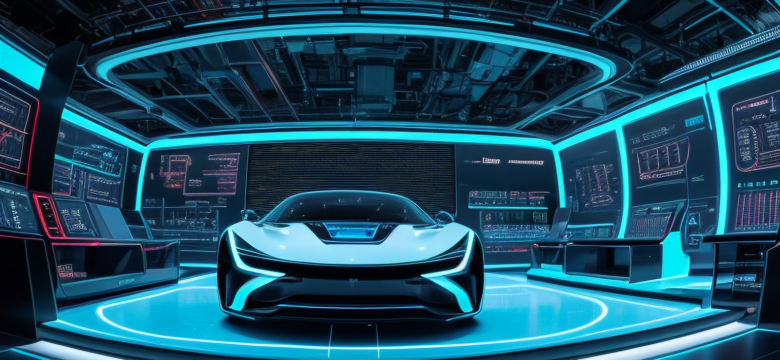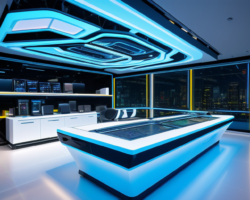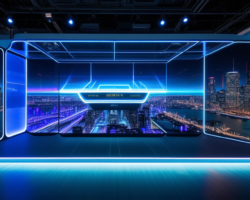In today’s rapidly evolving world, groundbreaking innovations are reshaping our understanding of what is feasible. From the realms of healthcare to the corridors of technology, these advancements are not just enhancing our lives but are also pushing the boundaries of human potential. Have you ever imagined a world where diseases could be diagnosed with pinpoint accuracy, or where machines could predict failures before they happen? This is not science fiction; it’s happening right now!
Take a moment to consider the impact of artificial intelligence in our daily lives. It’s like having a super-smart assistant that learns from every interaction, making our tasks easier and more efficient. As we dive deeper into this article, we will explore how these innovations are not only transforming industries but are also paving the way for a future that was once thought to be mere fantasy. Are you ready to discover how the impossible is becoming possible?
As we traverse through the various sectors, we will uncover the astonishing capabilities of technologies that are revolutionising medicine, redefining industries, and championing sustainability. Join us on this exciting journey and witness the future unfold before your eyes!
Revolutionary Technologies in Medicine
Advancements in medical technology are not just reshaping healthcare; they are redefining what we thought was possible. Imagine a world where diseases can be treated at the genetic level, where doctors can diagnose conditions remotely, and where treatments are tailored to individual patients’ needs. This is not science fiction; it’s the reality being crafted by revolutionary technologies.
One of the most exciting developments is gene editing, particularly through techniques like CRISPR. This technology allows scientists to modify DNA with unprecedented precision, opening doors to curing genetic disorders that were once considered incurable. For instance, conditions like sickle cell anaemia and certain types of cancer are now within reach of targeted therapies that could change lives forever.
Moreover, telemedicine is transforming patient care by enabling healthcare providers to connect with patients through digital platforms. This not only enhances access to care, especially in remote areas, but also streamlines the process of receiving medical attention. Patients can consult with specialists without the need for travel, saving both time and resources. The convenience of telemedicine is evident; it allows for:
- Quick access to healthcare professionals
- Reduced waiting times for appointments
- Increased patient engagement in their own health management
As we embrace these innovations, the future of medicine looks brighter than ever. With ongoing research and development, who knows what other miraculous advancements await us? The possibilities are endless, and the potential impact on patient outcomes is truly inspiring.
Artificial Intelligence: The Game Changer
Artificial Intelligence (AI) is not just a buzzword; it’s a revolution that’s reshaping our world. Imagine a world where machines can learn and adapt, making decisions that enhance efficiency and productivity. From finance to healthcare, AI is becoming the backbone of numerous industries, automating processes and providing insights that were once considered mere fantasy.
Take the finance sector, for example. AI algorithms can analyse vast amounts of data in seconds, identifying trends and making predictions that help businesses make informed decisions. Similarly, in customer service, chatbots powered by AI provide instant support, improving customer satisfaction while reducing operational costs. It’s like having a super assistant who never sleeps!
One of the most exciting aspects of AI is its subset, machine learning. This technology allows systems to learn from experience, continuously improving their performance. For instance, in healthcare diagnostics, machine learning can sift through enormous datasets to spot diseases earlier than traditional methods. This timely intervention can be a matter of life and death.
However, with great power comes great responsibility. As we embrace these advancements, we must also consider the ethical dilemmas they present. The question arises: how do we ensure that AI is developed responsibly and benefits society as a whole? Balancing innovation with ethics is crucial as we navigate this exciting frontier.
Machine Learning Applications
Machine learning, a fascinating subset of artificial intelligence, is transforming the way we interact with technology and data. Imagine a world where systems can learn from experience, adapt, and improve without human intervention. This isn’t science fiction; it’s happening right now! From predictive analytics in business to personalised marketing strategies, machine learning is at the heart of these innovations, making it possible to tailor experiences to individual needs.
In the realm of healthcare, machine learning is a game changer. By analysing vast datasets, algorithms can identify patterns that humans might miss, leading to earlier and more accurate diagnoses. For instance, consider how machine learning can enhance the detection of diseases such as cancer. The technology can sift through thousands of medical images and patient records, pinpointing anomalies that could indicate a health issue. This capability not only improves patient outcomes but also streamlines the diagnostic process, making it faster and more efficient.
In industries like manufacturing, machine learning is revolutionising operations through predictive maintenance. Instead of waiting for equipment to fail, companies can now foresee potential breakdowns before they occur. This proactive approach not only reduces downtime but also significantly lowers operational costs. By leveraging historical data and real-time monitoring, businesses can ensure their machinery operates smoothly, akin to having a crystal ball that predicts the future of their operations.
To sum it up, the applications of machine learning are vast and varied, impacting numerous sectors. As we continue to explore its potential, the question remains: what other possibilities could this technology unlock? The future looks bright, and we’re just scratching the surface!
Healthcare Diagnostics
In the realm of healthcare, machine learning is not just a buzzword; it’s a revolutionary force that’s reshaping how we diagnose diseases. Imagine a world where doctors can predict illnesses before symptoms even appear—this is becoming a reality thanks to advanced algorithms that analyse vast datasets. By harnessing the power of big data, these systems can sift through millions of records, identifying patterns that the human eye might miss.
For instance, consider how machine learning can enhance diagnostic accuracy. Traditional methods often rely on subjective interpretations, but with AI, we can achieve a new level of precision. These systems can flag anomalies in medical images or laboratory results, leading to earlier interventions. This proactive approach not only saves lives but also reduces healthcare costs significantly.
Moreover, the potential applications are astounding:
- Early Detection: Identifying diseases such as cancer at their nascent stages, improving the chances of successful treatment.
- Personalised Medicine: Tailoring treatments based on individual genetic profiles, leading to more effective therapies.
- Streamlined Processes: Automating routine diagnostics, allowing healthcare professionals to focus on patient care.
As we move forward, the integration of machine learning in healthcare diagnostics is not just enhancing our ability to treat diseases; it’s paving the way for a future where healthcare is more accessible, efficient, and effective. The possibilities are indeed endless!
Predictive Maintenance in Industry
Predictive maintenance is like having a crystal ball for machinery; it allows industries to foresee potential equipment failures before they become catastrophic. By leveraging machine learning and advanced data analytics, companies can monitor the health of their machinery in real-time. This proactive approach not only minimises downtime but also significantly reduces operational costs. Imagine a factory where machines send alerts about their performance, allowing technicians to address issues before they escalate—this is the reality that predictive maintenance brings.
At the heart of this innovation lies the ability to analyse vast amounts of data collected from machinery. Sensors embedded within equipment gather critical information, which is then processed to identify patterns and anomalies. For instance, if a machine’s temperature rises beyond a certain threshold, the system can predict that a failure might occur soon. This capability not only saves money but also enhances safety for workers.
To illustrate the impact of predictive maintenance, consider the following table that highlights its benefits:
| Benefit | Description |
|---|---|
| Cost Reduction | Minimises unexpected repairs and maintenance costs. |
| Increased Efficiency | Optimises machine performance and utilisation. |
| Enhanced Safety | Reduces the risk of accidents caused by equipment failure. |
In conclusion, predictive maintenance is transforming the industrial landscape by enabling companies to operate more efficiently and safely. As technology continues to evolve, we can expect even more sophisticated solutions that will redefine how industries maintain their equipment.
AI Ethics and Challenges
As we leap into the future with artificial intelligence, we must also confront the ethical dilemmas it presents. It’s like riding a rollercoaster; exhilarating yet terrifying. The potential of AI to transform our lives is immense, but with great power comes great responsibility. How do we ensure that these technologies are developed and used in a way that is fair, transparent, and beneficial for all?
One of the most pressing concerns is the issue of bias in AI algorithms. If the data fed into these systems is flawed or biased, the outcomes can perpetuate discrimination. Imagine a hiring algorithm that favours certain demographics over others simply because of the data it was trained on. This calls for rigorous oversight and the implementation of ethical guidelines in AI development.
Moreover, as AI takes over more tasks, we face the challenge of job displacement. While automation can improve efficiency, it also raises questions about the future of work. How do we prepare our workforce for an AI-driven economy? It’s crucial to invest in education and reskilling programmes to ensure that individuals can thrive in this changing landscape.
Ultimately, the goal is to strike a balance between innovation and ethical responsibility. We need to foster a dialogue among stakeholders, including technologists, policymakers, and the public, to navigate these challenges effectively. After all, a future shaped by AI should be one that enhances human potential rather than undermines it.
Sustainable Innovations for a Greener Future
As we stand at the crossroads of environmental crisis and technological advancement, sustainable innovations are emerging as beacons of hope. These groundbreaking technologies not only aim to reduce our carbon footprint but also pave the way for a more sustainable future. Imagine a world where our energy needs are met through renewable sources like solar and wind, drastically cutting down our reliance on fossil fuels. This isn’t just a dream; it’s becoming a reality!
One of the most exciting developments is in the field of renewable energy solutions. For instance, solar panel efficiency has skyrocketed, making it easier for households and businesses to harness the sun’s power. Wind energy is also witnessing remarkable advancements, with turbines becoming more efficient and capable of generating energy even in low-wind conditions. These innovations are not only environmentally friendly but also economically viable, as the costs associated with installation and maintenance continue to decline.
In addition, sustainable agriculture practices are revolutionising the way we grow food. Techniques such as vertical farming and precision agriculture are optimising resource use while minimising ecological footprints. By utilising technology to monitor crop health and soil conditions, farmers can significantly reduce water usage and chemical inputs. This not only ensures food security but also protects our precious ecosystems.
With innovations like these, we are not just dreaming of a greener future; we are actively building it. As we embrace these sustainable technologies, we take a significant step towards ensuring a healthier planet for generations to come.
Renewable Energy Solutions
In today’s world, the shift towards renewable energy has become not just a choice but a necessity. With the looming threat of climate change, innovations in renewable energy are paving the way for a sustainable future. Imagine harnessing the power of the sun or the wind to fuel our daily lives—this is no longer a distant dream but a reality that is unfolding before our eyes.
Technologies like solar panels and wind turbines are becoming increasingly efficient, allowing us to capture energy more effectively than ever. For instance, advancements in solar technology have led to the development of perovskite solar cells, which promise higher efficiency rates at a lower cost. Similarly, modern wind turbines are designed to operate in a wider range of wind conditions, maximising energy production.
Moreover, the integration of energy storage solutions is crucial. Batteries are evolving, with innovations like lithium-sulphur and solid-state technologies, enabling us to store renewable energy for use during peak demand times. This not only enhances reliability but also ensures that renewable sources can compete with traditional fossil fuels.
As we look ahead, the potential for renewable energy solutions is staggering. Consider the following:
- Reduction in greenhouse gas emissions
- Job creation in the green technology sector
- Enhanced energy security and independence
In conclusion, the innovations in renewable energy are not just about technology; they represent a shift in our approach to energy consumption and environmental stewardship. By embracing these solutions, we can create a cleaner, more sustainable world for future generations.
Sustainable Agriculture Practices
Sustainable agriculture is not just a buzzword; it’s a vital approach that ensures we can feed the growing global population without compromising the health of our planet. Imagine a farming system that not only produces food but also enhances the environment. This is the essence of sustainable agriculture. It involves methods that optimise resource use while minimising ecological footprints. For instance, vertical farming is making waves in urban areas, allowing crops to be grown in stacked layers, utilising space efficiently and reducing the need for pesticides. Additionally, precision agriculture employs technology to monitor and manage field variability, ensuring that every drop of water and every ounce of fertiliser is used effectively.
These practices are essential for achieving food security and maintaining environmental health. By embracing sustainable methods, farmers can:
- Reduce water consumption through efficient irrigation techniques.
- Enhance soil health with crop rotation and organic farming.
- Decrease greenhouse gas emissions by adopting renewable energy sources.
Ultimately, sustainable agriculture is about balance. It’s about producing enough food to nourish our population while also taking care of the planet. The innovations in this field are not just transforming farms; they are paving the way for a greener, more resilient future.
Frequently Asked Questions
- What are some examples of revolutionary technologies in medicine?
Revolutionary technologies in medicine include gene editing techniques like CRISPR, telemedicine platforms that allow remote consultations, and advanced imaging technologies that provide better diagnostic capabilities. These innovations are reshaping how healthcare is delivered and improving patient outcomes.
- How is artificial intelligence changing industries?
Artificial intelligence is automating processes, enhancing decision-making, and providing insights that were previously unimaginable. For example, in finance, AI algorithms can predict market trends, while in manufacturing, they optimise production lines. This not only increases efficiency but also drives innovation across various sectors.
- What role does machine learning play in healthcare?
Machine learning significantly enhances healthcare diagnostics by analysing large datasets to identify patterns and predict diseases. This leads to earlier interventions and more accurate diagnoses, ultimately improving patient care and outcomes.
- What are some sustainable innovations for a greener future?
Sustainable innovations include advancements in renewable energy sources like solar and wind, as well as sustainable agriculture practices such as vertical farming and precision farming. These technologies aim to reduce environmental impact and promote efficient resource use.





